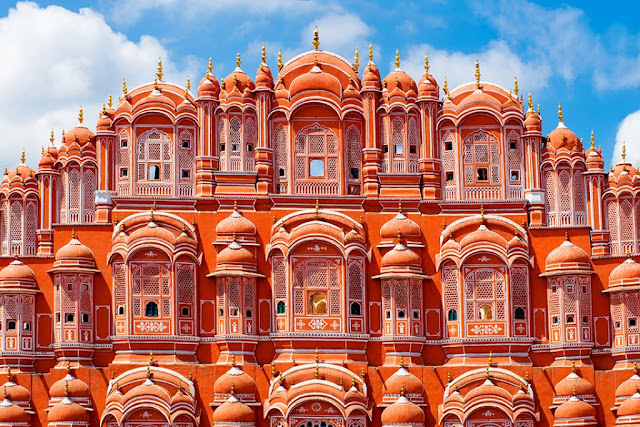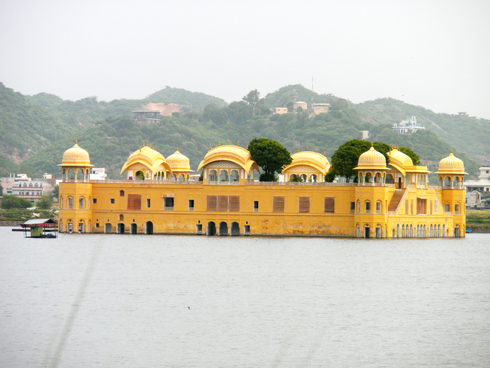Visit to the Hawa Mahal
Hawa Mahal or the 'Royal residence Of The Winds' situated in the core of the wonderful Pink City of Jaipur in Rajasthan, India, is a standout amongst the most well-known vacation destinations and an unmistakable point of interest of the city that is prestigious for it's rich social and design history. Worked in 1799 by Maharaja Sawai Pratap Singh of the Kachhwaha Rajput administration, this lovely structure is transcendently a high screen divider made of pink and red sandstone that encouraged regal ladies to get an eyeful of the road celebrations and occupied city life while staying out of the perspective of open. This five-story working in the state of a crown of Lord Krishna with 953 jharokhas or windows and a flawlessly beautified façade looking like a honeycomb of a colony that gives one a vibe of the rich legacy of the Rajputs.
History and Later Developments
Maharaja Sawai Pratap Singh, a grandson of the immense Maharaja Sawai Jai Singh who assembled Jaipur, developed the Hawa Mahal in 1799. He has so inspired with the Khetri Mahal worked by Maharaja Bhopal Singh in the town of Jhunjhunu, Rajasthan that he set out on developing the Hawa Mahal that today remains as a surprising diamond of Rajput style of design. It was worked as an augmentation of the Royal City Palace and prompts the zenana or ladies' chambers. One of the fundamental reasons of building this wonderful mahal enhanced with fine grid windows and screened overhangs was to encourage the regal Rajput ladies, who generally took after the strict Purdah framework and avoided showing up in broad daylight, in getting a look at the every day occasions, imperial parades and celebrations occurring in the city. Along these lines, they could make the most of their feeling of flexibility while keeping up their traditions.
Engineering and Design of Hawa Mahal
The engineer of this extraordinary five-storied pyramidal castle with a stature of 15 m from its lifted base was Lal Chand Ustad. The plan of the building grandstands an astounding mix of Hindu Rajput engineering with that of the Islamic Mughal design. The previous style is discernable from the fluted columns, botanical examples and domed coverings while the curves and stone decorate filigree work are appearances of the last style.
Keeping in accordance with different celebrated historic points of the city, which is relevantly labelled as the 'Pink City', this landmark was worked with red and pink sandstone. Maharaja Sawai Pratap Singh's dedication towards Lord Krishna is showed from the outline of the structure of the castle that looks like the crown of the Lord. Despite the fact that not precisely a royal residence, it would seem that one from the road. The façade of the building unpredictably cut with wonderful themes is related to that of the honeycomb of a colony. A few potholes of the structure each having little cross section windows, etched sandstone flame broil and adorned arches give the building a look of a mass of semi-octagonal straights. There are an aggregate of 953 intricately cut jharokhas or windows, some of which are made of wood. These jharokhas were work in such a way, to the point that air courses normally through them making Venturi impact (specialist breeze) in this manner ventilating the whole structure amid the sweltering summers. Each jharokha has a little chamber where one can sit and see the road. Wellsprings at the centre of each chamber complimented well with the light breeze coursing through the jharokhas in this way upgrading the cooling impact of the chambers with Tanicargo Taxi in Jaipur
The splendidly considered plan, style and development of the Mahal made it the most loved resort of Maharaja Jai Singh and ended up well known for his perfect work of art. A magnificent entryway from the city royal residence side prompts the passage of the Hawa Mahal. Three two-storied structures encase a substantial patio on three sides with the Hawa Mahal situated on its eastern side. The patio by and by houses an archaeological historical centre. The inside of the mahal comprising of chambers as additionally sections and columns prompting the best story is however very plain and straightforward contrasted with the ornamented outside. The width of the main three stories is that of a solitary room while the initial two stories have yards. There are no stairs in the building and best stories can be achieved just by inclines.
A Visit to the Hawa Mahal
The Hawa Mahal that pulls in national and global voyagers going by Jaipur is situated in the southern piece of the city on Hawa Mahal Rd, Badi Choupad. It can be gone to on all days from 9:30 am to 4:30 pm, notwithstanding it is best seen at a young hour toward the beginning of the day when the brilliant beams of the Sun fall on this illustrious building giving it a more rich and stunning look. The old ancient rarities safeguarded in the exhibition hall of the mahal give one a look at the rich past, the social legacy and the overflowing way of life of the Rajputs. One can benefit a taxi or book an auto to achieve the goal. As summers in Rajasthan are excessively sweltering, the best time, making it impossible to visit Jaipur is from October to March when the climate of the city become lovely and Tanicargo Cab & Taxi in Jaipur
History and Later Developments
Maharaja Sawai Pratap Singh, a grandson of the immense Maharaja Sawai Jai Singh who assembled Jaipur, developed the Hawa Mahal in 1799. He has so inspired with the Khetri Mahal worked by Maharaja Bhopal Singh in the town of Jhunjhunu, Rajasthan that he set out on developing the Hawa Mahal that today remains as a surprising diamond of Rajput style of design. It was worked as an augmentation of the Royal City Palace and prompts the zenana or ladies' chambers. One of the fundamental reasons of building this wonderful mahal enhanced with fine grid windows and screened overhangs was to encourage the regal Rajput ladies, who generally took after the strict Purdah framework and avoided showing up in broad daylight, in getting a look at the every day occasions, imperial parades and celebrations occurring in the city. Along these lines, they could make the most of their feeling of flexibility while keeping up their traditions.
Engineering and Design of Hawa Mahal
The engineer of this extraordinary five-storied pyramidal castle with a stature of 15 m from its lifted base was Lal Chand Ustad. The plan of the building grandstands an astounding mix of Hindu Rajput engineering with that of the Islamic Mughal design. The previous style is discernable from the fluted columns, botanical examples and domed coverings while the curves and stone decorate filigree work are appearances of the last style.
Keeping in accordance with different celebrated historic points of the city, which is relevantly labelled as the 'Pink City', this landmark was worked with red and pink sandstone. Maharaja Sawai Pratap Singh's dedication towards Lord Krishna is showed from the outline of the structure of the castle that looks like the crown of the Lord. Despite the fact that not precisely a royal residence, it would seem that one from the road. The façade of the building unpredictably cut with wonderful themes is related to that of the honeycomb of a colony. A few potholes of the structure each having little cross section windows, etched sandstone flame broil and adorned arches give the building a look of a mass of semi-octagonal straights. There are an aggregate of 953 intricately cut jharokhas or windows, some of which are made of wood. These jharokhas were work in such a way, to the point that air courses normally through them making Venturi impact (specialist breeze) in this manner ventilating the whole structure amid the sweltering summers. Each jharokha has a little chamber where one can sit and see the road. Wellsprings at the centre of each chamber complimented well with the light breeze coursing through the jharokhas in this way upgrading the cooling impact of the chambers with Tanicargo Taxi in Jaipur
The splendidly considered plan, style and development of the Mahal made it the most loved resort of Maharaja Jai Singh and ended up well known for his perfect work of art. A magnificent entryway from the city royal residence side prompts the passage of the Hawa Mahal. Three two-storied structures encase a substantial patio on three sides with the Hawa Mahal situated on its eastern side. The patio by and by houses an archaeological historical centre. The inside of the mahal comprising of chambers as additionally sections and columns prompting the best story is however very plain and straightforward contrasted with the ornamented outside. The width of the main three stories is that of a solitary room while the initial two stories have yards. There are no stairs in the building and best stories can be achieved just by inclines.
A Visit to the Hawa Mahal
The Hawa Mahal that pulls in national and global voyagers going by Jaipur is situated in the southern piece of the city on Hawa Mahal Rd, Badi Choupad. It can be gone to on all days from 9:30 am to 4:30 pm, notwithstanding it is best seen at a young hour toward the beginning of the day when the brilliant beams of the Sun fall on this illustrious building giving it a more rich and stunning look. The old ancient rarities safeguarded in the exhibition hall of the mahal give one a look at the rich past, the social legacy and the overflowing way of life of the Rajputs. One can benefit a taxi or book an auto to achieve the goal. As summers in Rajasthan are excessively sweltering, the best time, making it impossible to visit Jaipur is from October to March when the climate of the city become lovely and Tanicargo Cab & Taxi in Jaipur



Comments
Post a Comment